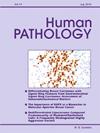Clinically aggressive follicular cell-derived thyroid carcinoma: A comprehensive series with histomolecular characterization and discovery of novel gene fusions
IF 2.7
2区 医学
Q2 PATHOLOGY
引用次数: 0
Abstract
Thyroid cancer rates are increasing, mostly with a good prognosis and less than 2 % of cases are more aggressive. Recent efforts focus on understanding molecular events predicting tumor aggressiveness and treatment targets in advanced thyroid cancer. This study concerned 57 patients with aggressive metastatic, and/or radioiodine-refractory thyroid carcinomas, excluding anaplastic cases. Molecular profiling, including next-generation sequencing and RNA sequencing, was conducted to dissect the complex molecular landscape of these aggressive tumors. Histopathological analysis indicated that papillary carcinomas and high-grade thyroid carcinomas were predominant. The molecular analysis revealed a spectrum of mutations, with prevalent occurrences of BRAF V600E, TERT promoter, and RAS mutations. RNA sequencing identified ten gene fusions, such as NTRK and RET fusions. Three novel fusions were discovered: UGGT1::TERT, BTBD9::TERT, and TG::IGF1R, potentially driving aggressive behavior. UGGT1::TERT was linked to radioiodine-refractory tall cell PTC, BTBD9::TERT to high-grade follicular PTC, and TG::IGF1R to oncocytic carcinoma. These findings underscore the importance of TERT alterations in aggressive phenotypes and offer insights into molecular mechanisms guiding targeted therapies. Further research is necessary to confirm their significance as diagnostic and prognostic markers in thyroid cancer.
临床侵袭性滤泡细胞源性甲状腺癌:组织分子特征和新型基因融合的综合系列研究
甲状腺癌的发病率在不断上升,大多数预后良好,只有不到2%的病例具有较强的侵袭性。最近的研究重点是了解晚期甲状腺癌中预测肿瘤侵袭性和治疗靶点的分子事件。本研究涉及57例侵袭性转移性和/或放射性碘难治性甲状腺癌患者,不包括无细胞病例。研究人员进行了分子谱分析,包括新一代测序和RNA测序,以剖析这些侵袭性肿瘤的复杂分子图谱。组织病理学分析表明,乳头状癌和高级别甲状腺癌占主导地位。分子分析发现了一系列突变,其中以BRAF V600E、TERT启动子和RAS突变最为常见。RNA 测序发现了十种基因融合,如 NTRK 和 RET 融合。还发现了三种新型融合基因:UGGT1::TERT、BTBD9::TERT 和 TG::IGF1R,这些基因融合可能会导致患者出现攻击性行为。UGGT1::TERT与放射性碘难治性高细胞PTC有关,BTBD9::TERT与高级别滤泡性PTC有关,而TG::IGF1R与肿瘤细胞癌有关。这些发现强调了 TERT 改变在侵袭性表型中的重要性,并为指导靶向疗法的分子机制提供了见解。有必要开展进一步研究,以确认它们作为甲状腺癌诊断和预后标志物的意义。
本文章由计算机程序翻译,如有差异,请以英文原文为准。
求助全文
约1分钟内获得全文
求助全文
来源期刊

Human pathology
医学-病理学
CiteScore
5.30
自引率
6.10%
发文量
206
审稿时长
21 days
期刊介绍:
Human Pathology is designed to bring information of clinicopathologic significance to human disease to the laboratory and clinical physician. It presents information drawn from morphologic and clinical laboratory studies with direct relevance to the understanding of human diseases. Papers published concern morphologic and clinicopathologic observations, reviews of diseases, analyses of problems in pathology, significant collections of case material and advances in concepts or techniques of value in the analysis and diagnosis of disease. Theoretical and experimental pathology and molecular biology pertinent to human disease are included. This critical journal is well illustrated with exceptional reproductions of photomicrographs and microscopic anatomy.
 求助内容:
求助内容: 应助结果提醒方式:
应助结果提醒方式:


